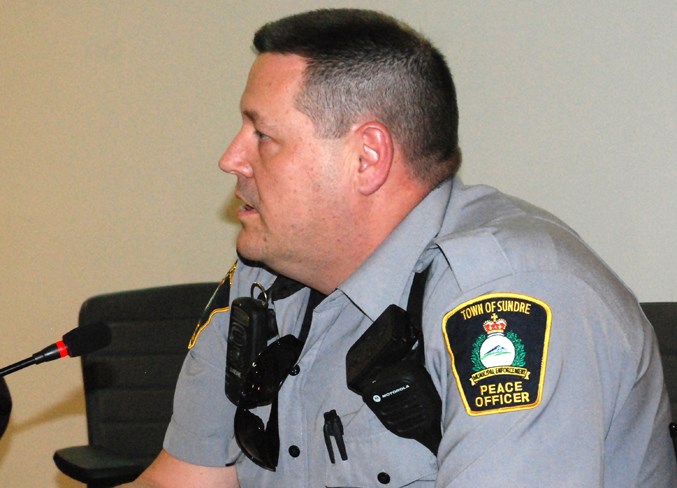Drivers entering a school zone are by law expected to reduce their speed to the posted 30 kilometres per hour before reaching the sign, and should not start accelerating until they have exited the zone.
Local law enforcement officials are reminding motorists in Sundre about the rules of the road after numerous drivers have been observed only slowing down after entering the zone as well as starting to accelerate before leaving it, said Kevin Heerema, the municipality’s community peace officer.
“You have to be at or below 30 (kilometres per hour) throughout the school zone, regardless of whether you’re heading into or out of it,” said Heerema.
“Some drivers start speeding up in the school zone on their way out.”
This applies not only to north- and southbound traffic on Centre Street by River Valley School but also along Second Avenue Northwest in front of Sundre High School, he said.
“One of the concerns has been speeds on the arena road,” he said, adding some drivers still tend to proceed through that area too fast.
Such unsafe practices typically do not start occurring until the end of the school year, he said, expressing concern considering classes started barely a month ago.
Sundre’s school zones are in effect from 8 a.m. to 4 p.m. every day that students are in class. During that time, children might be outside during recess, lunch break as well as physical education exercises or other outdoor activities, he said.
Although the playground and open field behind the elementary school is fenced in — hence why that stretch of Centre Street is considered a school zone as opposed to a playground zone — there always remains the possibility of activity, even on weekends, he said. Meanwhile, Second Avenue Northwest also provides access to the arena, the curling rink, the Aquaplex as well as the Sundre Skatepark, he said.
“It’s not unlikely to have kids playing in those areas,” he said, urging motorists that regardless of the time or day of the week to exercise caution.
Another matter of concern for local law enforcement has been instances of students disembarking from vehicles from the driver’s side, potentially exposing them to the danger of other motorists coming up from behind, he said.
“Parents should be unloading their children on the passenger side for safety’s sake.”
Additionally, due to the limited drop-off space at the school, many southbound drivers on Centre Street park on the road. While the peace officer does not oppose hastily and safely dropping off children, technically the zone is a no-parking area and drivers should not delay or leave their vehicles unattended, he said.
“I don’t mind allowing quick drop-offs, but unattended vehicles will be ticketed.”
Students and other pedestrians are also reminded to use marked crossings, he said, adding verbal warnings have been issued following several instances of jaywalking and that citations could be written up for repeated offences.
Meanwhile, he said on Main Avenue from the lights to the grocery store, there have been numerous traffic stops following a previous council meeting when elected officials discussed a concern about motorists who continue to turn across the double solid yellow lines.
Heerema said the simple solution for drivers seeking to access businesses is to proceed half a block to the next roundabout to make a U-turn and come back to safely enter the desired parking lot with a right-hand turn.
“It’s usually quicker than sitting there waiting for oncoming traffic.”
Not only is a motorist in violation of the law when stopping to turn left across double solid lines and waiting for oncoming traffic to clear, but the driver also creates a backup of vehicles behind them, he said. And when motorists start piling up behind a stopped car, that driver might also end up potentially feeling pressure to proceed unsafely, he said.
With winter driving conditions descending upon us sooner than usual, motorists are further encouraged to reduce speeds as well as turn their headlights on, he said, adding tail lights do not activate with only the default daylights running.
Although the peace officer also recommends winter tires, which make a huge difference for traction, steering and stopping, he said a quality set of all weather tires — provided of course they remain in good shape and that the operator drives to conditions — should do the trick.



